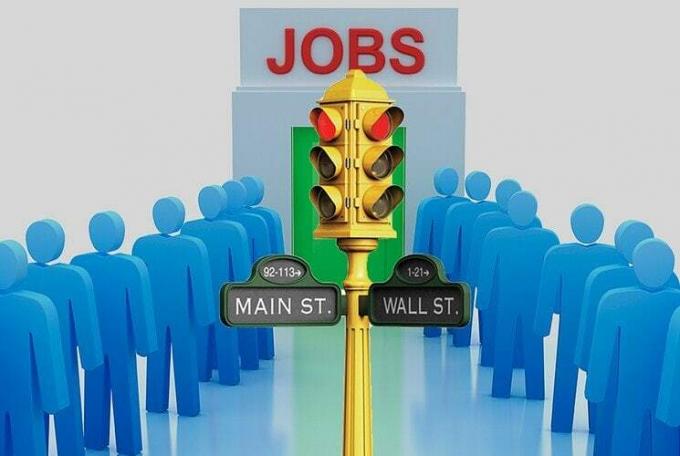Unemployment or unemployment, is the situation in which is any person who, having age, ability and desire to work, does not occupy a job and has difficulty getting it.
This involuntary leisure of someone who wants to find work meets the following conditions:
Advertisements
- The person is of the appropriate age to work.
- Dont have work.
- You are looking for work but you cannot find it.
- You are willing to work.
According to this order of ideas, unemployment is a involuntary phenomenon on the side of individuals, but it must also be said that it is also involuntary on the side of companies, since they do not have the income and capacity to hire more staff. Therefore, unemployment is also defined as the economic inability of a country to absorb the entire labor force in its population.
Unemployment is a problem that generates great concern in society. Unemployed people face difficult situations due to lack of income to support themselves and their families. Situation that also affects the production and growth of companies and the country itself due to the lack of purchasing power of these people to be able to buy products and therefore when the number of unemployed people grows above normal levels, concern appears throughout the society.

Advertisements
In this article you will find:
Working market
This is the name given to the market where the supply and demand for labor converge.
- The offer: Formed by the set of citizens in capacity and willing to work.
- The demand: Set of employer companies that are able to hire workers.
The labor market is of great importance in society. Its malfunction affects the economic growth and to the employment of a country bringing important economic and social consequences:
Advertisements
- Economic: Unemployment admits a potential loss of production.
- Social: Harmful effects on the apportionment of income and from there on social cohesion.
The unemployment rate
It is a measure of the dilation of unemployment. During periods of economic recession, there is a relatively high unemployment rate.
It is calculated as a percentage, dividing the number of unemployed people, that is, they take into account those people of working age who seek actively and do not find employment, among all the people who are in the labor force, that is, what is known as population active.
Advertisements
The market is in equilibrium when starting from a situation, where the demanded work is absorbed by the supply of the active population. It is broken when an economic recession occurs, companies will sell less. Therefore, they will produce less and demand less amount of work in the market. The supply will be greater than the demand for labor.
As a result of a smaller amount of work and a greater number of people with a desire to be employed, sometimes the shock of the situation is so strong that it pushes wages down. This will reduce the consumption of goods and services, affecting companies which will sell less and will be forced to lower prices and narrow margins. All this goes around in a circle or chain known as a deflationary spiral since it occurs when there is contraction or deflation.
Advertisements
Effects of unemployment
Having a high unemployment rate is a serious problem for a country, since it directly affects its economic growth.
Therefore, the effects of unemployment can be:
- Economic:
- The decline in real production.
- The decline in demand.
- The increase in the public deficit.
- Social: effects that affect the citizen and his social relationship.
- Psychological damages.
- Discriminatory effects in the social environment.
What are your causes?
- It is the time it takes a person to find the job that suits their tastes and their qualities and abilities.
- It is the legislation on the minimum wage. Said legislation obliges unskilled and inexperienced workers to pay a salary higher than the equilibrium wage, which increases the supply of labor and reduces the demand. Overwork represents unemployment.
- The market power of unions that act for the benefit of the worker often achieve higher than equilibrium wages for unionized sectors and excess work is created.
- The theory of efficiency wages. According to which it is more profitable for companies to pay higher than equilibrium wages than can improve the health of workers, compress their turnover, optimize their quality and increase their effort.
Another cause of unemployment, but no less important, is inequality, obtained by analyzing the distribution of the labor rate, with respect to attributes. According to this it can be:
- Inequality by age can occur in young people with their first job, also directly discriminating in terms of educational level.
- Inequality by sex, with the highest incidence in the female population to exercise force work where it is judged by its stereotype.
- Inequality by activity, important differences are judged between the different productive sectors.
- Inequality by regions, occurs as a phenomenon related to location since there are regions where the force Work is absorbed by activities typical of the area and if you are not suitable for it you are unemployed or unemployed.
Types of unemployment
The types of unemployment are given according to their cause, the most common are:
Seasonal unemployment
It is caused by changes in the demand for labor, due to the season of the year. For example, in the tourism sector, which in high season be it summer, Easter, school holidays, Christmas or other, absorbs new workers and once the activity is completed and the business returns to the usual rhythm, these workers are left again unemployment.
Frictional unemployment
It is voluntary, it is applied by people who, being able to work, decide to train, rest or look for a job that better suits their qualities and tastes and for this they take some time.
Structural unemployment
It is due to irregularities between the qualification or location of the workplace and the qualification demanded by the employer.
Cyclical unemployment
When the workers and the productive factors that remain, are left idle due to a moment in that economic activity is sufficient to employ all, locate the factors productive.
Disguised unemployment
When there are people whose productive capacity is underused in their workplace.


